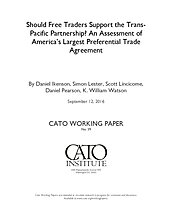Legislation to implement the TPP could be introduced in Congress this year, but with caustic anti-trade rhetoric permeating the presidential election campaigns and the major-party candidates publicly opposing the deal, prospects for passing such legislation in 2016 look bleak. Election-year politics aside, skepticism and, in some cases, outright opposition to the TPP have been registering across the political and ideological spectra. The usual anti-trade arguments from labor, environmental, and other groups on the left have been supplemented by free-market oriented assertions that the TPP is too much about global governance and too little about market liberalization.
Although often referred to as a free trade agreement, the TPP is not really about free trade. Like all so-called free trade agreements, the TPP is about managed trade. The deal includes broad swaths of liberalization — “freer” trade — as well as rules and provisions that serve other, sometimes less liberal purposes.
The agreement’s 30 chapters deal with traditional trade issues, such as: market access for goods, services, and agricultural products; rules of origin; and, customs- and other border-related issues. But it also includes rules affecting e‑commerce, the operations of state-owned enterprises, the formulation of regulations, intellectual property, investment policy, labor policy, environmental policy, and other policy areas that are less obviously associated with trade or trade barriers.
Whether free traders should support ratification of the TPP depends on whether, and to what extent, they wish to avoid making the perfect the enemy of the good. If free trade purity is the benchmark, then the TPP fails the test. But what if the deal includes more trade liberalization than protectionism and can be deemed net liberalizing? Should that be enough? Does it depend on specific provisions in specific chapters?
This paper presents a chapter-by-chapter analysis of the TPP from a free trader’s perspective.1 Brief summaries, assessments, scores on a scale of 0 (protectionist) to 10 (free trade), and scoring rationales are provided for each evaluated chapter. Of the 22 chapters analyzed, we found 15 to be liberalizing (scores above 5), 5 to be protectionist (scores below 5), and 2 to be neutral (scores of 5). Considered as a whole, the terms of the TPP are net liberalizing.
Note
1 We were able to analyze and “score” 22 of the 30 TPP chapters. Eight chapters did not lend themselves to qualification or scoring.





